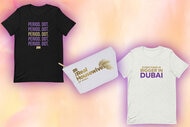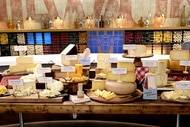
Create a free profile to get unlimited access to exclusive videos, sweepstakes, and more!
WTF Is a "Wine Product" Anyway? (And... Can You Drink It?)
They're cheap and convenient. Sounds great, right?

There’s a ton to learn when it comes to the world of wine, from pairings to varietals to how much you should actually spend on a decent bottle. But adding to the confusion are these low-alcohol beverages dubbed “wine products.” They're often bottled to look exactly like regular wine, the price is super affordable, and you can conveniently find them in grocery stores, drugstores, and bodegas in states like New York... where wine legally isn’t allowed to be sold.
But look closely at the bottle and you’ll see the phrase “wine product” on the label. What exactly is this stuff and is it actually worth a try?
The short answer is no, you’re not going to want to pour yourself a glass of this stuff — ever. “It’s made from grapes, but it’s not really wine,” says Brahm Callahan, a master sommelier and beverage director of Himmel Hospitality Group in Boston.
Take a sip and you’ll be unpleasantly surprised by a sweet substance that tastes more like grape juice than vino. During the usual wine fermentation process, sugars from the grapes are converted almost entirely into alcohol, creating that (usually) delicious wine we all know and love. Makers of wine products, however, purposely leave a ton of residual sugar in the stuff, since they need to keep the bottle’s percentage of alcohol (also known as alcohol by volume or ABV) low.
“It has to do with taxes and the way the federal government classifies everything; that’s why you’ll often see beer in stores and not wine,” explains Callahan. "Companies pay less taxes if it’s not a full-fledged bottle of wine and because it’s less regulated, it’s a way to get way around getting some products into stores that might not have a liquor license.”
In most states, when an alcoholic beverage has less than seven percent alcohol by volume, it falls into a different category than wine (which typically has an ABV of anywhere from 11 to to 15 percent) or hard alcohol. As for what’s exactly these these wine products, it can be hard to tell. “Often these low-level grocery story wines are fermented, and then there are a bunch of different ways they can lower the alcohol, and then they add sugar or color or whatever they want to add,” he says.
So is the driving force behind these wine products a way to trick buyers who want something cheap or is it simply to make an alcoholic beverage that’s allowed to be sold everywhere that wine isn't? “It’s probably a combination of all of that. Someone just figuring out a way to sell alcohol,” says Callahan. “And they’re at a price point where people who are buying it don’t really care.”














